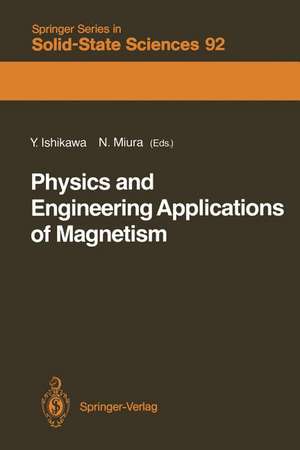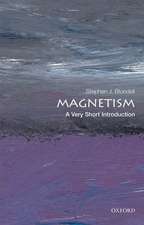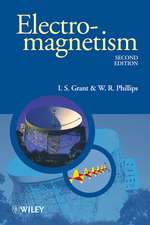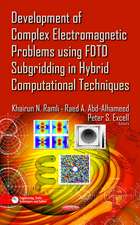Physics and Engineering Applications of Magnetism: Springer Series in Solid-State Sciences, cartea 92
Editat de Yoshikazu Ishikawa Contribuţii de K. Adachi Editat de Noboru Miura Contribuţii de S. Chikazumi, E. Hirota, N. Imamura, Y. Ishikawa, Y. Makino, N. Miura, T. Mizoguchi, Y. Nakamura, Y. Sugita, K. Tajima, M. Takahashi, A. Tonomura, T. Wakiyamaen Limba Engleză Paperback – 12 feb 2012
Din seria Springer Series in Solid-State Sciences
- 18%
 Preț: 1225.94 lei
Preț: 1225.94 lei - 18%
 Preț: 1017.62 lei
Preț: 1017.62 lei - 15%
 Preț: 532.05 lei
Preț: 532.05 lei - 18%
 Preț: 944.51 lei
Preț: 944.51 lei -
 Preț: 541.46 lei
Preț: 541.46 lei - 18%
 Preț: 962.35 lei
Preț: 962.35 lei -
 Preț: 385.84 lei
Preț: 385.84 lei - 18%
 Preț: 1827.48 lei
Preț: 1827.48 lei - 15%
 Preț: 661.02 lei
Preț: 661.02 lei -
 Preț: 389.88 lei
Preț: 389.88 lei - 15%
 Preț: 639.59 lei
Preț: 639.59 lei - 15%
 Preț: 635.15 lei
Preț: 635.15 lei - 18%
 Preț: 896.21 lei
Preț: 896.21 lei - 15%
 Preț: 647.92 lei
Preț: 647.92 lei - 15%
 Preț: 651.34 lei
Preț: 651.34 lei - 18%
 Preț: 890.23 lei
Preț: 890.23 lei - 15%
 Preț: 640.55 lei
Preț: 640.55 lei - 15%
 Preț: 649.54 lei
Preț: 649.54 lei - 15%
 Preț: 645.60 lei
Preț: 645.60 lei - 15%
 Preț: 644.30 lei
Preț: 644.30 lei - 15%
 Preț: 653.79 lei
Preț: 653.79 lei - 18%
 Preț: 956.69 lei
Preț: 956.69 lei - 15%
 Preț: 637.59 lei
Preț: 637.59 lei - 23%
 Preț: 1043.41 lei
Preț: 1043.41 lei - 15%
 Preț: 639.08 lei
Preț: 639.08 lei - 15%
 Preț: 648.24 lei
Preț: 648.24 lei - 15%
 Preț: 637.46 lei
Preț: 637.46 lei - 15%
 Preț: 640.06 lei
Preț: 640.06 lei -
 Preț: 391.40 lei
Preț: 391.40 lei -
 Preț: 390.84 lei
Preț: 390.84 lei - 15%
 Preț: 638.57 lei
Preț: 638.57 lei - 18%
 Preț: 1006.06 lei
Preț: 1006.06 lei - 18%
 Preț: 730.79 lei
Preț: 730.79 lei - 15%
 Preț: 640.37 lei
Preț: 640.37 lei - 15%
 Preț: 643.65 lei
Preț: 643.65 lei - 18%
 Preț: 1231.01 lei
Preț: 1231.01 lei - 18%
 Preț: 950.21 lei
Preț: 950.21 lei - 15%
 Preț: 642.68 lei
Preț: 642.68 lei - 15%
 Preț: 640.55 lei
Preț: 640.55 lei - 18%
 Preț: 1229.10 lei
Preț: 1229.10 lei
Preț: 390.63 lei
Nou
Puncte Express: 586
Preț estimativ în valută:
74.75€ • 77.23$ • 62.18£
74.75€ • 77.23$ • 62.18£
Carte tipărită la comandă
Livrare economică 19 martie-02 aprilie
Preluare comenzi: 021 569.72.76
Specificații
ISBN-13: 9783642841606
ISBN-10: 3642841600
Pagini: 340
Ilustrații: XIII, 317 p.
Dimensiuni: 155 x 235 x 18 mm
Greutate: 0.48 kg
Ediția:Softcover reprint of the original 1st ed. 1991
Editura: Springer Berlin, Heidelberg
Colecția Springer
Seria Springer Series in Solid-State Sciences
Locul publicării:Berlin, Heidelberg, Germany
ISBN-10: 3642841600
Pagini: 340
Ilustrații: XIII, 317 p.
Dimensiuni: 155 x 235 x 18 mm
Greutate: 0.48 kg
Ediția:Softcover reprint of the original 1st ed. 1991
Editura: Springer Berlin, Heidelberg
Colecția Springer
Seria Springer Series in Solid-State Sciences
Locul publicării:Berlin, Heidelberg, Germany
Public țintă
ResearchCuprins
1. Progress in the Physics of Magnetism in the Past Forty-five Years.- 1.1 Magnetism of 3d Transition Metals and Alloys.- 1.2 Magnetism of Rare Earth Metals and Alloys.- 1.3 Magnetism of Ferrimagnetic Oxides.- 1.4 Observation of Ferromagnetic Domains.- 1.5 Experimental Techniques and Environments.- 1.6 Engineering Applications of Magnetic Materials.- 1.7 Conclusions.- References.- 2. Generation of Megagauss Magnetic Fields and Their Application to Solid State Physics.- 2.1 Various Techniques for Generating Ultra-high Magnetic Fields.- 2.2 Electromagnetic Flux-Compression.- 2.3 Single-Turn Coil Technique.- 2.4 Magnetism Experiments in Megagauss Fields.- References.- 3. Magnetism in Metals and Alloys Studied by Neutron Scattering.- 3.1 Significance of Neutron Scattering for the Study of Magnetism.- 3.2 Studies of Antiferromagnetic Metals with Elastic Scattering.- 3.3 Ferromagnetic Metals Studied by Inelastic Scattering.- 3.4 Spin Dynamics in Localized Spin Systems.- 3.5 Spin Dynamics in Itinerant Electron Systems.- 3.6 Spin Dynamics in Quasi-Localized Spin Systems.- 3.7 Dynamic Behavior of Invar Alloys.- 3.8 Epilogue — The Magnetism of Fe and Ni.- Addendum.- References.- 4. Magnetic Properties of 3d Compounds with Special Reference to Pyrite Type Compounds.- 4.1 General Survey of 3d Magnetic Compounds.- 4.2 Experimental Results.- 4.3 Theoretical Interpretation.- References.- 5. Invar Systems.- 5.1 Magnetovolume Effects.- 5.2 Invar Type Alloys.- 5.3 Elasticity.- 5.4 Conclusions.- References.- 6. Magnetic Anisotropy and Magnetostriction.- 6.1 Magnetocrystalline Anisotropy.- 6.2 Magnetostriction.- 6.3 Representative Materials and Topics.- 6.4 Realization of High Magnetic Permeability. “The Focus of Zero” in Magnetic Anisotropy and Magnetostriction.- 6.5 InducedMagnetic Anisotropy. How to Control the Shape of Magnetization Curves.- References.- 7. The Intermediate Field Between Pure and Applied Magnetism. Importance of Accurate Measurements of Magnetization Curves.- 7.1 Technical Terms and Figures.- 7.2 Estimation of Saturation Magnetization and Curie Temperatures.- 7.3 Magnetic Anisotropy.- 7.4 Magnetostriction and Magneto-elastic Energy.- 7.5 Spin Glasses, Hopkinson Effect and the Invar Problem.- 7.6 The Problem of Communication Between Applied Researchers and Those in the “Intermediate Fields” or in Basic Research.- 7.7 Conclusion.- References.- 8. Amorphous Magnetic Materials.- 8.1 Magnetization and Temperature Dependence of Amorphous Magnetic Materials.- 8.2 Magnetic Anisotropy.- 8.3 Magnetism, Preparation Conditions and Structural Relaxation of Amorphous Alloys.- References.- 9. Amorphous Magnetic Alloy Ribbons and Their Applications.- 9.1 Materials.- 9.2 Applications.- References.- 10. Magneto-optical Recording.- 10.1 Principles of Recording, Reproducing and Erasing.- 10.2 Requirements for Recording Media.- 10.3 Recording Media.- 10.4 Dynamic Read Write Properties.- 10.5 Applications and Other Technologies.- References.- 11. Magnetic Bubble Memories. Solid State File Utilizing Micro Magnetic Domains.- 11.1 Physics of Magnetic Bubbles.- 11.2 Magnetic Bubble Materials.- 11.3 Magnetic Bubble Devices.- 11.4 Magnetic Bubble Memories and Applications.- 11.5 Future Trends of Magnetic Bubble Devices and Memories.- 11.6 Summary.- References.- 12. High Density Magnetic Recording. Recent Developments in Magnetic Tapes, Discs and Heads.- 12.1 Physics of Magnetic Recording.- 12.2 Magnetic Tapes and Discs.- 12.3 Magnetic Heads.- 12.4 Future Trends.- References.- 13. Magnetic Domains Observed by Electron Holography.- 13.1Principles of Electron Holography.- 13.2 Principles of Domain Structure Observation.- 13.3 Applications of Magnetic Domain Structure Observation.- 13.4 Summary.- References.- Appendix: Notes on Technical Terms.













